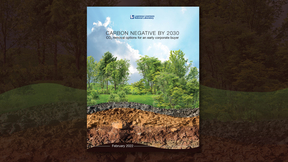Back
Recent scientific advancements in fusion, combined with increasing private investments and the urgent need to address climate change, mean the “time is now” for accelerating fusion energy commercialization, fusion experts said at a White House summit on March 17. Hosted by the White House Office of Science and Technology Policy (OSTP) and the U.S. Department of Energy (DOE…
Lawrence Livermore National Laboratory (LLNL) celebrated the 2022 Global Women in Data Science (WiDS) conference on March 7 with its fifth annual regional event, featuring workshops, mentoring sessions and a discussion with LLNL Director Kim Budil, the first woman to hold that role. For the second straight year, the WiDS Livermore event was entirely virtual due to the…
Carbon exhibits a remarkable tendency to form nanomaterials with unusual physical and chemical properties, arising from its ability to engage in different bonding states. Many of these “next-generation” nanomaterials, which include nanodiamonds, nanographite, amorphous nanocarbon and nano-onions, are currently being studied for possible applications spanning quantum…
Lawrence Livermore National Laboratory (LLNL) scientists exploring the interaction between cancer cells and the extracellular matrix (ECM) — the “scaffolding” of organs — found that proteins in the ECM can dramatically impact the immune system’s ability to kill tumors. Researchers said the findings, published online in the journal Biomaterials, could represent a novel…
In the National Ignition Facility (NIF), the world’s highest-energy laser system, a complex series of glass optics — including amplifiers, mirrors, wavelength converters and focusing lenses — strengthens and guides the laser light to its destination. Over the years, researchers have developed and refined these optics so they can withstand the intense energies generated by…
Lawrence Livermore National Laboratory’s decades of leadership in developing high-energy lasers is being tapped to provide a key component of a major upgrade to SLAC National Accelerator Laboratory’s Linac Coherent Light Source (LCLS). Over the next several years, LLNL’s Advanced Photon Technologies (APT) program will design and construct one of the world’s most powerful…
If a cancer patient tests positive for COVID-19, are they more likely to become hospitalized from the disease? That depends on certain risk factors, according to a new study by researchers at Lawrence Livermore National Laboratory (LLNL) and the University of California, San Francisco (UCSF), who looked to identify cancer-related risks for poor outcomes from COVID-19…
An international team led by scientists from the University of Oxford Department of Physics, the University of Rochester and the University of Chicago turned to Lawrence Livermore National Laboratory’s (LLNL’s) National Ignition Facility (NIF) to help unravel the inner workings of heat conduction in clusters of galaxies — the largest structures in the universe. These…
Whether dead or alive, soil microorganisms play a major role in the biogeochemical cycling of carbon in the terrestrial biosphere. But what is the specific role of death for the bacteria, fungi and microfauna that make up the soil microbiome? That is the topic of a new review by Lawrence Livermore National Laboratory (LLNL) scientists and collaborators. The article,…
An international team of scientists has found new biomarkers that can be used for diagnostic purposes and potentially as predictive tools of the risks associated with deep-space flight. In their study, the team, including three researchers from Lawrence Livermore National Laboratory (LLNL), examined approximately two-decade-old blood samples from space shuttle astronauts…
Research conducted at Lawrence Livermore National Laboratory (LLNL) describes a validation exercise for simple models used to understand hot-spot conditions reached in an implosion, which find good agreement when compared to a set of simulations. Progress toward ignition requires accurately diagnosing current conditions and assessing proximity metrics for implosion…
Lawrence Livermore National Laboratory (LLNL) scientists have provided input on Microsoft’s pathway to become carbon-negative by 2030. LLNL researchers built on their pivotal report "Getting to Neutral: Options for Negative Carbon Emissions in California," which has become a trusted adviser in the discussion of how to remove carbon dioxide from the air, to make…
Most metal alloys are prone to corrosion, which costs hundreds of billions of dollars of damage annually in the U.S. alone. Accurately predicting corrosion rates is a long-standing goal of corrosion science, but these rates depend strongly on the specific operating environment. At the atomic scale, these environmental factors are associated with how quickly and easily…
A Lawrence Livermore National Laboratory (LLNL) team has developed a comprehensive dynamic model of COVID-19 disease progression in hospitalized patients, finding that risk factors for complications from the disease are dependent on the patient’s disease state. Using a machine learning algorithm on a dataset of electronic health records (EHRs) from more than 1,300…
Earth’s supply of water is incredibly important for its ability to sustain life, but where did that water come from? Was it present when Earth formed or was it delivered later by meteorites or comets from outer space? The source of Earth’s water has been a longstanding debate and Lawrence Livermore National Laboratory (LLNL) scientists think they have the answer — and they…
Lawrence Livermore National Laboratory (LLNL), Penn State (PSU) and University of Arizona (UA) researchers are partnering with industry collaborator Western Rare Earths (WRE), U.S. subsidiary of American Rare Earths Limited, to use a naturally occurring protein to extract and purify rare earth elements (REEs) from abundant, domestic ore-based feedstocks and waste materials…
The Society for Industrial and Applied Mathematics (SIAM) announced Lawrence Livermore National Laboratory computational mathematician Rob Falgout as the recipient of the 2022 SIAM Activity Group on Supercomputing Career Prize. Established in 2009, the career prize recognizes “broad and distinguished contributions to the field of algorithms research and development for…
Antibiotics have allowed for the widespread control of bacterial infections, which had been the leading cause of death historically. However, the overuse of traditional antibiotics in humans and animals resulted in the emergence of stronger, more potent bacterial strains that are no longer treatable with conventional antibiotics. Researchers at Lawrence Livermore National…
The Veterans/Military Outreach and Recruiting Program at Lawrence Livermore National Laboratory (LLNL) is committed to supporting and recruiting military students, reservists, active duty and transitioning service men, women and veterans. The program’s initial focus on recruiting and hiring has aided directly in the employment of nearly 500 veterans, with many more serving…
Lawrence Livermore National Laboratory (LLNL) scientists have developed a custom microscope to image microbes in soil and plants at the micrometer scale. Live imaging of microbes in soil would help scientists understand how soil microbial processes occur on the scale of micrometers, where microbial cells interact with minerals, organic matter, plant roots and other…
























